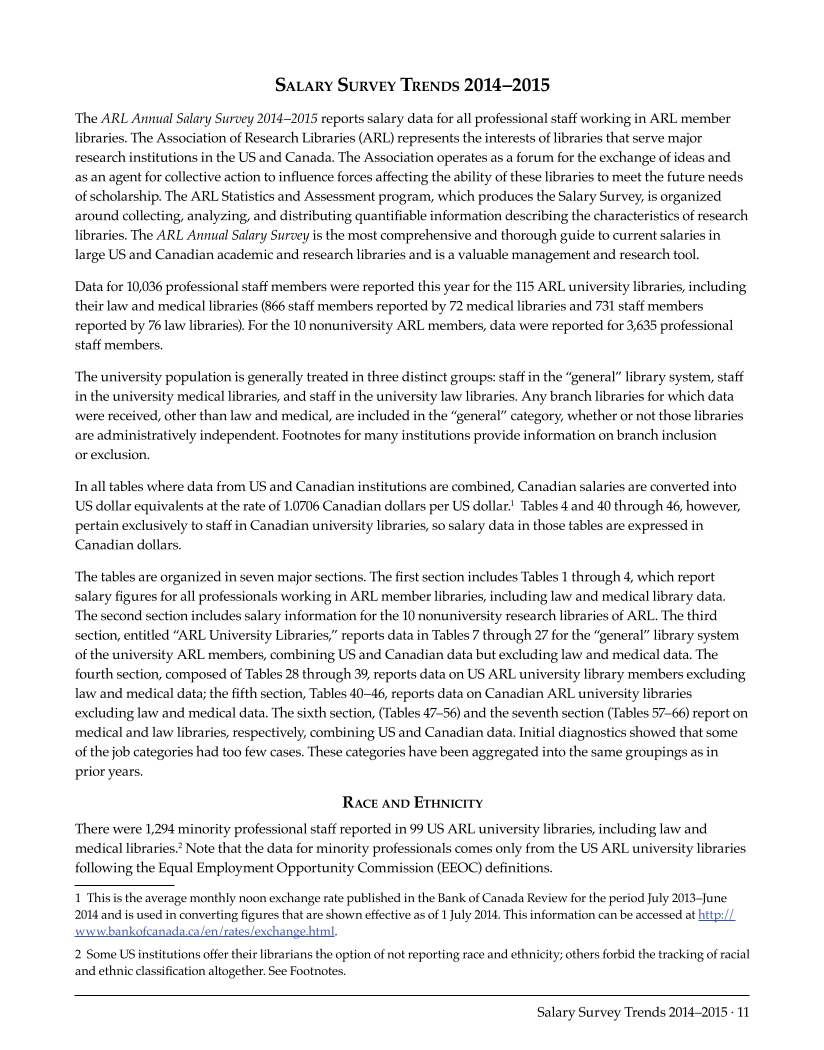Salary Survey Trends 2014–2015 · 11 Salary Survey Trends 2014–2015 The ARL Annual Salary Survey 2014–2015 reports salary data for all professional staff working in ARL member libraries. The Association of Research Libraries (ARL) represents the interests of libraries that serve major research institutions in the US and Canada. The Association operates as a forum for the exchange of ideas and as an agent for collective action to influence forces affecting the ability of these libraries to meet the future needs of scholarship. The ARL Statistics and Assessment program, which produces the Salary Survey, is organized around collecting, analyzing, and distributing quantifiable information describing the characteristics of research libraries. The ARL Annual Salary Survey is the most comprehensive and thorough guide to current salaries in large US and Canadian academic and research libraries and is a valuable management and research tool. Data for 10,036 professional staff members were reported this year for the 115 ARL university libraries, including their law and medical libraries (866 staff members reported by 72 medical libraries and 731 staff members reported by 76 law libraries). For the 10 nonuniversity ARL members, data were reported for 3,635 professional staff members. The university population is generally treated in three distinct groups: staff in the “general” library system, staff in the university medical libraries, and staff in the university law libraries. Any branch libraries for which data were received, other than law and medical, are included in the “general” category, whether or not those libraries are administratively independent. Footnotes for many institutions provide information on branch inclusion or exclusion. In all tables where data from US and Canadian institutions are combined, Canadian salaries are converted into US dollar equivalents at the rate of 1.0706 Canadian dollars per US dollar.1 Tables 4 and 40 through 46, however, pertain exclusively to staff in Canadian university libraries, so salary data in those tables are expressed in Canadian dollars. The tables are organized in seven major sections. The first section includes Tables 1 through 4, which report salary figures for all professionals working in ARL member libraries, including law and medical library data. The second section includes salary information for the 10 nonuniversity research libraries of ARL. The third section, entitled “ARL University Libraries,” reports data in Tables 7 through 27 for the “general” library system of the university ARL members, combining US and Canadian data but excluding law and medical data. The fourth section, composed of Tables 28 through 39, reports data on US ARL university library members excluding law and medical data the fifth section, Tables 40–46, reports data on Canadian ARL university libraries excluding law and medical data. The sixth section, (Tables 47–56) and the seventh section (Tables 57–66) report on medical and law libraries, respectively, combining US and Canadian data. Initial diagnostics showed that some of the job categories had too few cases. These categories have been aggregated into the same groupings as in prior years. Race and Ethnicity There were 1,294 minority professional staff reported in 99 US ARL university libraries, including law and medical libraries.2 Note that the data for minority professionals comes only from the US ARL university libraries following the Equal Employment Opportunity Commission (EEOC) definitions. 1 This is the average monthly noon exchange rate published in the Bank of Canada Review for the period July 2013–June 2014 and is used in converting figures that are shown effective as of 1 July 2014. This information can be accessed at http:// www.bankofcanada.ca/en/rates/exchange.html. 2 Some US institutions offer their librarians the option of not reporting race and ethnicity others forbid the tracking of racial and ethnic classification altogether. See Footnotes.












































































































































































